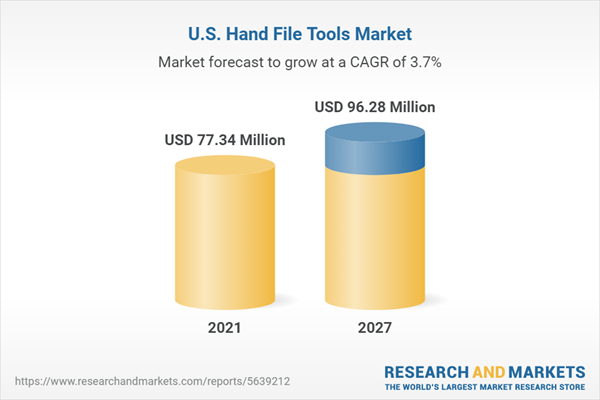Speak directly to the analyst to clarify any post sales queries you may have.
Regarding geographics, in California, the number of people employed in jobs related to tool grinders, filers, and sharpeners was the highest among other U.S. states. Over 500,000 people were employed in the installation, maintenance, and repair occupations where there is significant usage of hand file tools which is expected to boost the hand file tools market in the region.
IMPACT OF COVID-19
The U.S. hand file tools market plunged along with the hand tools market due to the pandemic since most economic operations were suspended in 2020, particularly in Q1 and Q2 2020. Most major revenue-generating end-users, such as construction, automotive, commercial remodeling, and interior development, were impacted, resulting in a drop in hand tool sales, thus adversely affecting the hand file tools market. The curfew and lockdown procedures restricted employees and contractors from using hand file tools and other hand tools. This led to hurting the industry’s overall income creation during the period. Hand drills, wrenches, drivers, cutters, and saws, which were previously thought to be the most revenue-generating equipment in the market, were known to be used less frequently in early 2020.
MARKET OPPORTUNITY & CHALLENGES
- Rising Demand For Chainsaws
Now, the chainsaw tools also need to be well maintained for their efficient performance, for which chainsaw files are essential. Thus, the hike in demand for chainsaws directly affects the saw files industry in the country. So, the demand for chainsaw tools is directly proportional to saw file tools, thus driving the market.
- Growth In Automotive Sector
It was observed that the people of the U.S. are quite inclined toward buying electric vehicles, and the demand for them is expected to surge, which would positively affect the manufacturing of cars in the region. This phenomenon will increase the demand for raw materials, machinery, and other equipment required to manufacture vehicles. This indicates that the machinery would also require its due maintenance, thereby boosting the U.S. hand file tools market during the forecast period.
- Manufacturers Shifting Production Facilities From Us To Other Countries
SEGMENTATION INSIGHTS
INSIGHTS BY TYPE
Hand file tools are necessary to resize, alter, or carve objects made of metal or wood. Even though they could seem like very basic instruments, files take particular ability and technique to get the desired outcome from the workpiece. Most of the time, files are used on metals, although they may also be used to scrape wooden objects. Additionally, files may be divided into the groups Saw files and Machinist files. Materials are shaped and finished with machinist files, also known as engineer's files. Machinist files come in various forms and are employed in several contexts.Market Segmentation by File Type
- Machinist Files
- Saw Files
- Others
Market Segmentation by Machinist Files
- Flat & Hand Files
- Round Files
- Half Round Files
- Square Files
- Triangular Files
- Others
Market Segmentation by Saw Files
- Taper Files
- Chainsaw File
- Mill File
- Others
INSIGHTS BY APPLICATION
Metal instruments, known as file tools, are typically used to remove excess or pointless material from a work item. Typically, woodworking and metalworking employ files. In addition, files are utilized for extracurricular activities and other comparable jobs. The majority of files have the same structure; however, they differ when it comes to their functionality. On wooden workpieces, a file is often not utilized; it is only used on metal. To change the sizes and forms of metal objects and for deburring and scraping reasons, files are employed on metal parts.Market Segmentation by Application
- Metal Work
- Woodwork
INSIGHTS BY GRADES OF CUT
Even though all files carry out the same function, a wide range of files are accessible for various uses. There are several types of files, and they vary in terms of shape, substance, length, and cut grades. In files, there are about six distinct cut grades: rough, coarse, bastard, second cut, smooth, and dead smooth. The two most popular cuts of the previously described bastard are second cut and smooth cut. When we discuss cut grades, we're referring to the number of teeth per inch or centimeter. There are more than 20 different cross-sectional designs, patterns, or forms. The single-cut file has rows of parallel teeth cut diagonally across their working surfaces. The double-cut file has teeth that cross over one another in rows. The degree of coarseness or spacing of the teeth determines the classification of single- and double-cut files. Depending on the tooth's shape and size, the teeth' density per inch varies dramatically. The degree of coarseness or spacing of the teeth determines the classification of single- and double-cut files.Market Segmentation by Grades of Cut
- Bastard Cut
- Second Cut
- Smooth Cut
REGIONAL ANALYSIS
The U.S. is one of the most well-developed countries and has a robust infrastructure, perfect for various industries to grow and thrive. Similar is the case for the automotive, aerospace, and defense industry that have witnessed quite a consistent growth. These industries are the major end users of the hand file tools because all the manufacturing in these industries demands a high degree of precision, for which hand files play a crucial part.Given the current Ukraine and Russia war scenario, the U.S. has been very vocal about its support for Ukraine. It has invested billions of dollars through defense machines and equipment, thus increasing the demand for hand file tools in the region.
The U.S. also houses many major automobile manufacturers. Ford and General Motors, amongst many other players in the automobile industries, use hand file tools to attain precision during manufacturing, thus pumping the U.S. hand file tools market for growth.
Market Segmentation by Region
- California
- Michigan
- Oregon
- Alabama
- Washington
COMPETITIVE LANDSCAPE
The U.S. produces the highest revenue regarding hand file tools in North America. Regarding types of hand file tools, the machinist type of files is the most common choice amongst all the available in the U.S. market, generating a revenue of over USD 35 million. The machinist hand files hold over 46% of the U.S. hand file tools market, thus dominating the machinist hand files industry. Saw-type file tools are the second most revenue-generating type of hand file tools in the United States. It generated more than USD 22 million in the year 2021. The overall hand file tools market is expected to grow at a CAGR of more than 3.5%.The market competition is expected to increase further with a surge in product differentiation and innovation growth, which broadens the scope for utilizing a broader range of categories in the market. The U.S. players are anticipated to grow by acquiring other players in the industry.
Key Vendors
- Stanley Black & Decker
- Snap On Incorporated
- Apex Tool Group (ATG)
Other Prominent Vendors
- Wruth
- ICS Cutting Tools
- Zoro UK
- Remax Tools
- Falcon Tool Company
- WoodWorld of Texas
- Ampco Safety Tools
- Western States Hardware, Inc.
- Intercon USA Inc.
- DME Company
- Genius Tools USA
- Warrensville File & Knife
- AVEN SAFETY TOOLS
- Michiganpneumatic.com
- Federal File Co.
- McKeever/Wiltshire File Company
KEY QUESTIONS ANSWERED
1. How big is the U.S. hand file tools market?2. What is the growth rate of the U.S. hand file tools market?
3. Who are the key players in the U.S. hand file tools market?
4. What growth factors drive the U.S. hand file tools market demand?
4. Which file type holds the largest U.S. hand file tools market share?
Table of Contents
Companies Mentioned
- Stanley Black & Decker
- Snap On Incorporated
- Apex Tool Group (ATG)
- Wruth
- ICS Cutting Tools
- Zoro UK
- Remax Tools
- Falcon Tool Company
- WoodWorld of Texas
- Ampco Safety Tools
- Western States Hardware, Inc.
- Intercon USA Inc.
- DME Company
- Genius Tools USA
- Warrensville File & Knife
- AVEN SAFETY TOOLS
- Michiganpneumatic.com
- Federal File Co.
- McKeever/Wiltshire File Company
Methodology
Our research comprises a mix of primary and secondary research. The secondary research sources that are typically referred to include, but are not limited to, company websites, annual reports, financial reports, company pipeline charts, broker reports, investor presentations and SEC filings, journals and conferences, internal proprietary databases, news articles, press releases, and webcasts specific to the companies operating in any given market.
Primary research involves email interactions with the industry participants across major geographies. The participants who typically take part in such a process include, but are not limited to, CEOs, VPs, business development managers, market intelligence managers, and national sales managers. We primarily rely on internal research work and internal databases that we have populated over the years. We cross-verify our secondary research findings with the primary respondents participating in the study.

LOADING...
Table Information
| Report Attribute | Details |
|---|---|
| No. of Pages | 165 |
| Published | October 2022 |
| Forecast Period | 2021 - 2027 |
| Estimated Market Value ( USD | $ 77.34 Million |
| Forecasted Market Value ( USD | $ 96.28 Million |
| Compound Annual Growth Rate | 3.7% |
| Regions Covered | United States |
| No. of Companies Mentioned | 19 |









